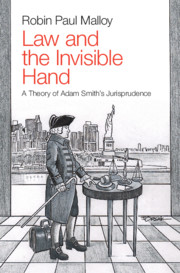Book contents
- Law and the Invisible Hand
- Law and the Invisible Hand
- Copyright page
- Dedication
- Contents
- About the Cover
- Figures
- About the Author
- Preface
- Acknowledgments
- Guide to Citations by Adam Smith
- 1 Introduction
- 2 Setting the Stage
- 3 Social Organization in the Informal Realm
- 4 Social Organization in the Formal Realm
- 5 Integrating the Informal and Formal in Smith’s Theory
- 6 The Spectator View
- 7 Judgment and Justice
- 8 The Sentiment of Common Interest
- 9 The Impartial Spectator, Homo economicus, and Homo identicus
- 10 Understanding the Four Stages of Progress
- 11 Adam Smith in American Law
- 12 Parting Thoughts
- Bibliography
- Index
5 - Integrating the Informal and Formal in Smith’s Theory
Published online by Cambridge University Press: 27 September 2021
- Law and the Invisible Hand
- Law and the Invisible Hand
- Copyright page
- Dedication
- Contents
- About the Cover
- Figures
- About the Author
- Preface
- Acknowledgments
- Guide to Citations by Adam Smith
- 1 Introduction
- 2 Setting the Stage
- 3 Social Organization in the Informal Realm
- 4 Social Organization in the Formal Realm
- 5 Integrating the Informal and Formal in Smith’s Theory
- 6 The Spectator View
- 7 Judgment and Justice
- 8 The Sentiment of Common Interest
- 9 The Impartial Spectator, Homo economicus, and Homo identicus
- 10 Understanding the Four Stages of Progress
- 11 Adam Smith in American Law
- 12 Parting Thoughts
- Bibliography
- Index
Summary
Adam Smith’s theory of jurisprudence accounted for informal as well as formal elements of social organization. The informal elements have been with humankind for as long as can be remembered – since the earliest stage of hunting and gathering. Informal arrangements arose out of norms and cultural practices responsive to three underlying human characteristics. These characteristics included: the natural pursuit of self-interest; the ability to sympathize with others; and the ability to be self-reflective in making judgments concerning one’s own behavior and the behavior of others. The formal elements evolved over time as civic institutions. They evolved in response to the rising complexity of human cooperation as society progressed through Smith’s four stages. Formal institutions included those of economics, politics, and law.
- Type
- Chapter
- Information
- Law and the Invisible HandA Theory of Adam Smith's Jurisprudence, pp. 59 - 64Publisher: Cambridge University PressPrint publication year: 2021

